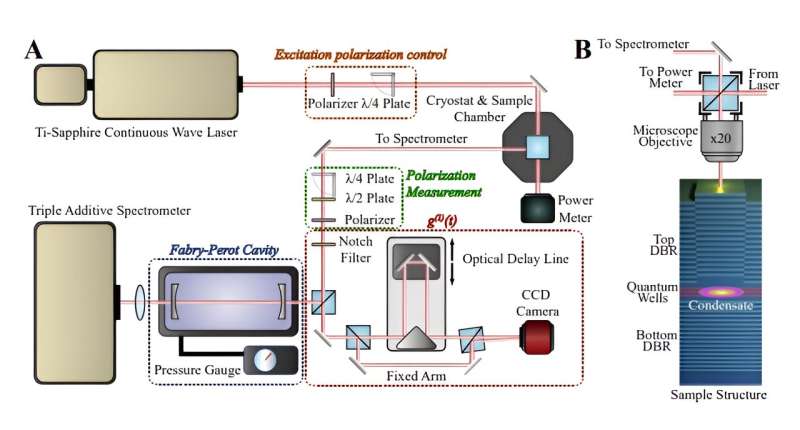This article has been reviewed according to Science X's editorial process and policies. Editors have highlighted the following attributes while ensuring the content's credibility:
fact-checked
peer-reviewed publication
proofread
On-chip GHz time crystals with semiconductor photonic devices pave way to new physics and optoelectronic applications

Researchers have for the first time observed a time crystal on a microscale semiconductor chip oscillating at a rate of several billion times per second, unveiling exceptionally high non-linear dynamics in the GHz range.
The results of the experiment, published in Science, establish a firm connection between formerly uncorrelated areas of non-linear exciton-polariton dynamics and coherent optomechanics at GHz frequencies, say researchers from the Paul-Drude-Institute for Solid State Electronics (PDI) in Berlin, Germany, and the Argentina-based Centro Atómico Bariloche and Instituto Balseiro (CAB-IB).
The research was carried out using a high-quality semiconductor-based sample that acts as a trap for coherent light-matter condensates.
Designed and fabricated at PDI, the sample was created by stacking one-atom-thick layers of semiconductor materials under ultrahigh vacuum conditions, eventually forming a micron-sized "box" with the ability to trap millions of quantum particles. It was then transferred to CAB-IB for testing.
When the CAB-IB team directed a time-independent (i.e. continuous) laser at the sample, they observed that the particles it contained began to oscillate at GHz frequencies—a billion times per second.
This is the first time sustained oscillations in this range have been observed in a condensate sample on a semiconductor device.
The researchers also found that the oscillations could be fine-tuned by the laser's optical power, with the possibility to stabilize the free evolution of the frequency by engineered 20-GHz mechanical vibrations of the semiconductor atomic lattice.
In accordance with their theory, the researchers found that on further increasing the laser power, the particles vibrated at exactly half the frequency of the mechanical vibrations.
"This behavior can be interpreted as different manifestations of a time crystal," said Alexander Kuznetsov, a scientist at PDI.
"The demonstrated results add a new dimension to the physics of open many-body quantum systems, enabling frequencies several orders of magnitude higher than before and presenting new ways to control the emerging dynamics, which lead to the fascinating time crystals on a semiconductor platform."
What are time crystals?
Since Nobel-Prize-winning physicist Frank Wilczek first proposed his theory over a decade ago, researchers have been on the search for elusive "time crystals"—many-body systems composed of particles and quasiparticles like excitons, photons, and polaritons that, in their most stable quantum state, vary periodically in time.
Wilczek's theory centered around a puzzling question: Can the most stable state of a quantum system of many particles be periodic in time? That is, can it display temporal oscillations characterized by a beating with a well-defined rhythm?
It was quite rapidly shown that time crystal behavior cannot occur in isolated systems (systems which do not exchange energy with the surrounding environment). But far from closing the subject, this disturbing question motivated scientists to search for the conditions under which an open system (i.e., one that exchanges energy with the environment) may develop such time crystal behavior.
And while time crystals have now been observed on several occasions in systems driven out of equilibrium, much about them remains undetermined: their internal dynamics are largely beyond the current understanding of scientists, and their potential uses have remained in the realm of theory rather than practice.
"This work presents a paradigmatic shift in the approach to time crystals, by offering a possibility to extend such studies to arbitrary-large arrays (lattices) of localized time crystals to study their interactions and synchronization," said Alejandro Fainstein, the senior researcher and professor who led the CAB-IB team.
"Through it, we have been able to unveil peculiar behaviors of quantum materials. Because the materials involved are semiconductors compatible with integrated photonic devices, and the frequencies displayed are relevant for both classical and quantum information technologies, we envision additional stages in which we will try to control these behaviors for applications, including photon-to-radiofrequency conversion at the quantum level."
Potential applications
According to the research team, this experiment shows promise for using time crystals in integrated and microwave photonics.
"Due to the polariton-enhanced coupling between GHz phonons and near-infrared photons, the results have the potential for applications in (quantum) conversion between microwave and optical frequencies," said Paulo Ventura Santos, a senior scientist at PDI.
Semiconductor-based non-linear optoelectronic systems—devices that can convert light energy to electrical energy or vice versa—are drawing particular attention for their potential applications in on-chip photonics. But they are notoriously difficult to study due to the many-body complexes (such as time crystals) that determine their electronic and optical properties.
"A deeper understanding of well-defined regimes within these many-body systems, such as the ones the PDI/CAB-IB team helped to identify, can help elucidate these internal dynamics—and in turn help develop methods to control and harness such systems for applications," said Gonzalo Usaj, the theory leader from the CAB-IB team.
More information: I. Carraro-Haddad et al, Solid-state continuous time crystal in a polariton condensate with a built-in mechanical clock, Science (2024). DOI: 10.1126/science.adn7087
Journal information: Science
Provided by Paul-Drude-Institut für Festkörperelektronik



















